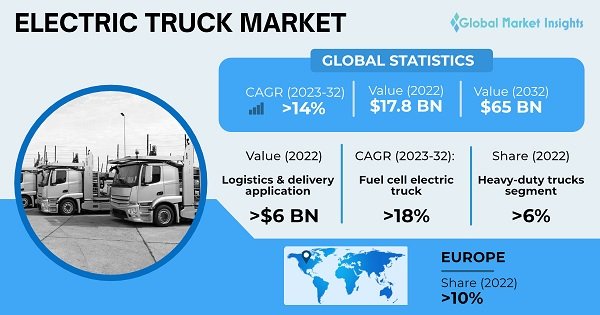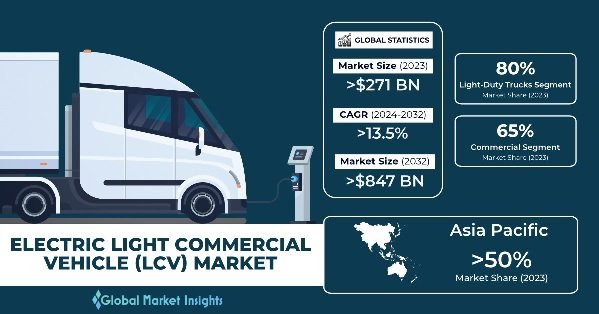Table of Contents:
- Introduction
- Key Drivers of Electric Commercial Vehicles
- Challenges and Considerations
- Future Trends
- Conclusion
- Frequently Asked Questions
Introduction:
Key Drivers of Electric Commercial Vehicles:

1. Government Initiatives:
- Substantial government incentives and mandates worldwide have propelled the adoption of electric vehicles, including commercial ones.
- Incentives such as tax credits, rebates, and grants encourage fleet operators to transition towards electric options.
- Stringent emission regulations in major markets push manufacturers to invest in electric vehicle technology.
2. Cost Savings:
- Long-term cost savings associated with electric commercial vehicles are a significant driving force.
- Lower fuel and maintenance costs contribute to the attractiveness of EVs, especially in high-mileage applications.
- The decreasing cost of batteries and advancements in technology are steadily closing the price gap between electric and traditional vehicles.
3. Environmental Concerns:
- Heightened awareness of environmental issues and the need to reduce carbon footprints have spurred interest in electric commercial vehicles.
- EVs offer zero tailpipe emissions, contributing to cleaner air quality and mitigating the impact of transportation on climate change.
- Businesses are increasingly prioritizing sustainability in their operations, driving the adoption of electric fleets.
4. Technological Advancements:
- Rapid advancements in battery technology and electric drivetrains have significantly enhanced the performance and range of electric commercial vehicles.
- Innovations such as fast-charging infrastructure and vehicle-to-grid (V2G) capabilities are addressing concerns regarding range anxiety and grid integration.
- Integration of telematics and connectivity solutions enable efficient fleet management and optimization of routes, further boosting the appeal of EVs.
Challenges and Considerations:

1. Infrastructure Development:
- The availability and accessibility of charging infrastructure remain a primary challenge for the widespread adoption of electric commercial vehicles.
- Investments in charging stations, both public and private, are essential to support the growing EV market and alleviate range anxiety among fleet operators.
- Collaboration between governments, utilities, and private entities is crucial to accelerate the deployment of charging infrastructure.
2. Range Limitations:
- Despite improvements, range limitations continue to be a concern, particularly for long-haul and heavy-duty applications.
- Manufacturers are focusing on developing higher-capacity batteries and enhancing charging technology to extend the range and reduce charging times.
- Fleet operators must carefully evaluate their operational needs and route profiles to determine the suitability of electric vehicles.
3. Initial Investment:
- The upfront cost of electric commercial vehicles remains higher than their conventional counterparts, posing a barrier to adoption for some businesses.
- However, the total cost of ownership over the vehicle’s lifespan often offsets the initial investment through savings in fuel and maintenance expenses.
- Financial incentives and leasing options can help mitigate the upfront costs and incentivize fleet electrification.
4. Supply Chain Constraints:
- The supply chain for key components such as batteries and electric drivetrains is susceptible to disruptions, impacting production and delivery timelines.
- Manufacturers are working to diversify their supply chains and invest in local production facilities to mitigate risks and ensure a steady supply of components.
- Collaboration and partnerships across the supply chain are essential to address potential bottlenecks and scale up production capacity.
5. Infrastructure Development:
- Limited charging infrastructure poses a significant challenge for electric commercial vehicles, especially for long-haul transportation.
- Building a robust network of charging stations along major transportation routes is essential to support the widespread adoption of electric commercial vehicles.
6. Battery Technology and Range Anxiety:
- Despite advancements, battery technology still faces challenges such as limited energy density and high costs.
- Range anxiety among fleet operators remains a concern, particularly for vehicles operating in remote areas or requiring frequent long-distance travel.
7. Vehicle Cost and ROI:
- The initial purchase cost of electric commercial vehicles is often higher than their conventional counterparts, impacting the return on investment for fleet operators.
- However, lower operational and maintenance costs over the vehicle’s lifecycle can offset the initial investment, making long-term savings attractive.
8. Regulatory Framework:
- Evolving regulations related to emissions standards and incentives for electric vehicles impact the market dynamics and adoption rate of electric commercial vehicles.
- Uncertainties surrounding future policies and incentives can influence investment decisions by fleet operators and manufacturers.
9. Supply Chain Challenges:
- Securing a stable supply chain for key components such as batteries and electric drivetrains is crucial for scaling up production of electric commercial vehicles.
- Global supply chain disruptions, such as those witnessed during the COVID-19 pandemic, highlight the need for resilience and localization in the supply chain.
Outlook and Future Trends:

1. Market Expansion:
- The electric commercial vehicle market is poised for significant growth, driven by increasing environmental regulations, technological advancements, and shifting consumer preferences.
- Market players are expanding their product portfolios and investing in research and development to meet the evolving needs of fleet operators across various sectors.
2. Emergence of New Players:
- The growing demand for electric commercial vehicles has attracted new entrants and startups to the market, fostering innovation and competition.
- Established automotive manufacturers are facing competition from startups specializing in electric vehicle technology, leading to rapid advancements and differentiation in product offerings.
3. Integration of Autonomous Technology:
- The integration of autonomous technology with electric commercial vehicles presents new opportunities for enhanced efficiency and safety.
- Autonomous features such as platooning and predictive maintenance have the potential to revolutionize fleet operations and reduce operational costs.
- Continued investments in research and development are expected to drive the convergence of electric and autonomous technologies in the commercial vehicle sector.
4. Advancements in Battery Technology:
- Continued research and development in battery technology are expected to improve energy density, reducing costs and extending the range of electric commercial vehicles.
- Innovations such as solid-state batteries hold promise for higher energy efficiency and faster charging capabilities.
5. Autonomous and Connected Vehicles:
- Integration of autonomous and connected technologies in electric commercial vehicles can enhance efficiency, safety, and productivity.
- Features such as predictive maintenance, real-time fleet management, and autonomous driving capabilities have the potential to revolutionize the logistics industry.
6. Electrification of Last-Mile Delivery:
- The rise of e-commerce and urbanization is driving the electrification of last-mile delivery vehicles.
- Electric vans and trucks equipped with optimized route planning and charging infrastructure cater to the growing demand for sustainable urban logistics solutions.
7. Collaborative Ecosystems and Partnerships:
- Collaborations between automotive manufacturers, technology companies, and energy providers are fostering innovation and accelerating the adoption of electric commercial vehicles.
- Joint ventures and strategic alliances aim to address challenges such as charging infrastructure development and battery recycling.
8. Circular Economy and Sustainability:
- Embracing a circular economy approach involves extending the lifecycle of electric vehicle batteries through reuse, remanufacturing, and recycling.
- Sustainable practices, such as eco-friendly materials sourcing and energy-efficient manufacturing processes, are integral to the long-term viability of electric commercial vehicles.
Conclusion:

Frequently Asked Questions:
The adoption of electric commercial vehicles is being primarily driven by factors such as increasing environmental regulations, rising fuel costs, advancements in battery technology, and a growing awareness of sustainability among businesses.
Businesses often encounter challenges related to high upfront costs, limited charging infrastructure, concerns about vehicle range, and the need for specialized training. These challenges can be mitigated through government incentives, investment in charging infrastructure, collaboration with manufacturers for customized solutions, and employee training programs.
Electric commercial vehicles typically offer lower operating costs due to reduced fuel and maintenance expenses. While initial purchase costs may be higher, electric vehicles often provide a quicker return on investment over their lifetime. Additionally, electric vehicles offer comparable performance in terms of torque and acceleration, making them suitable for various commercial applications.
In the coming years, we anticipate advancements in battery technology leading to increased energy density, longer ranges, and faster charging times. Moreover, improvements in vehicle design, including lightweight materials and aerodynamics, will further enhance efficiency. Additionally, advancements in autonomous driving technology are likely to revolutionize the commercial transportation sector.
To ensure a smooth transition, businesses should conduct thorough research to understand their specific operational requirements and assess the available electric vehicle options. Developing a comprehensive transition plan, including infrastructure upgrades, fleet management strategies, and employee training, is crucial. Collaborating with industry experts, leveraging government incentives, and staying updated on technological advancements will help businesses maximize the benefits of electrifying their commercial vehicle fleets.

